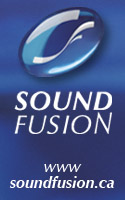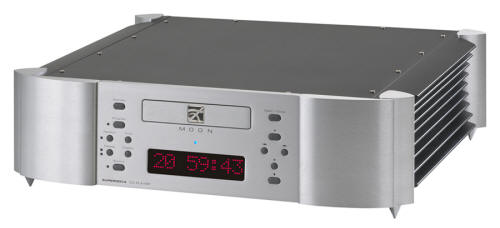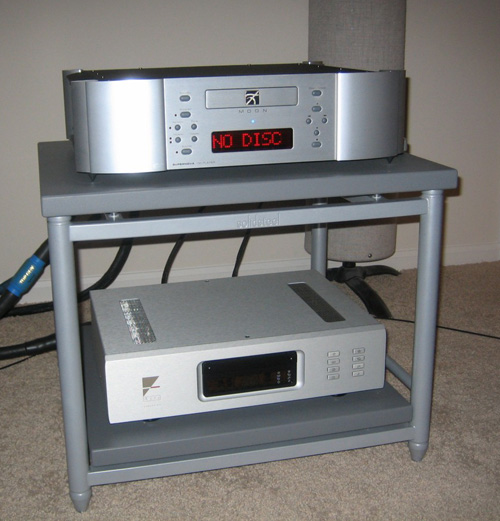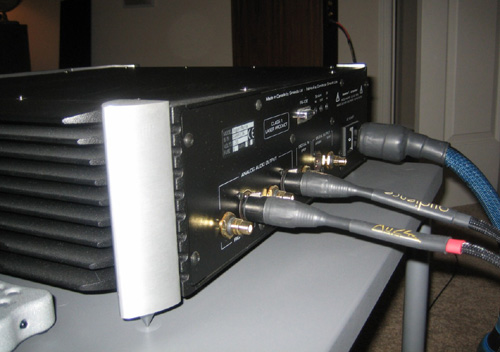
You are reading the older HTML site
Positive Feedback
ISSUE
27
simaudio
MOON SuperNova CD player
as reviewed by John Acton

|
JOHN ACTON'S SYSTEM
LOUDSPEAKERS
ELECTRONICS
SOURCES
CABLES
ACCESSORIES
|
Canadian audio/video manufacturer Simaudio has recently introduced a new flagship line of no-holds-barred audio components. At first glance, with their luxurious casework and numerous features designed for control flexibility and ease-of-use, the MOON Evolution components seem tailor-made for custom-install applications. We audiophiles could be excused for questioning whether the engineers at Simaudio haven't compromised their traditional emphasis on sheer performance as a tradeoff for broadening their customer base. Dig a little deeper, however, and it becomes readily apparent that is not the case, with the Evolution series representing the greatest assault on the state-of-art that the company has produced to-date. The entire line employs several key technological advancements and refinements, and is fully balanced from input to output, two-channel only, and in the case of their digital players, strictly Redbook CD compatible.
The MOON SuperNova is the smaller of two CD players in the Evolution lineup. While the flagship Andromeda player is a two-box, top-loading affair, the SuperNova is a more economical one-box front-loader. The SuperNova may be scaled down in comparison to its bigger brother, but it is a technological tour-de-force in its own right. A Philips L1210/S transport reads the disc, and the data is up sampled to 24 bits at a sample rate of 352.8kHz prior to being passed to a 24-bit Burr Brown PCM1798 differential DAC/digital filter. Separate power supplies are utilized for the digital and analog sections, both of which employ their own toroidal transformer. From there, a proprietary voltage regulation scheme (i2DCf—Independent Inductive DC filtering) ensures that one inductor is dedicated to each circuit (DAC, Op-Amp, etc) in the signal path, for a total of 20 stages. A precise digital clocking circuit ensures 25PPM accuracy for low jitter performance. A gentle 6dB/octave analog filter is employed before the signal reaches the differential output stage. Four-layer PCB tracings and a short signal path are utilized to improve the signal-to-noise ratio.
As advanced as the SuperNova is internally, its external appearance is every bit as impressive. Making use of a very rigid chassis construction, the SuperNova is as large and heavy as some power amps, measuring 18.75" wide by 5.5" high by 16.5" deep, and weighing in at 40 pounds. In regards to styling, the SuperNova retains the spiked four-column structure of the previous MOON components, but little else. Available with an all-silver, all-black or black-on-silver faceplate, the SuperNova allows for a number of spike and MOON logo cosmetic options. The front fascia comprises a center panel containing the CD tray, display readout and operational buttons, while the left and right ends are flared silver or black. Aside from the corner pillars, the sides are formed from very attractive extruded black heatsinks. All in all, the appearance of the SuperNova is at once very formidable and elegant. This is clearly a component that means business, but one that doesn't need to be hidden away from visitors and guests. The only quibble I have is with the SuperNova's CD tray. Constructed of plastic, and possessed of a slightly flimsy feel in operation, the CD tray is not up to the same subjective high level of quality as the rest of the player. I never experienced any problems in my normal day-to-day use, but I would have expected to see something a little sturdier.

The red dot-matrix display on the front faceplate is the largest and easiest-to-read that I've encountered on a component. Easily viewed from anywhere in the room, the display can be dimmed in three levels and turned off completely, if desired (at which point, it activates briefly in response to commands before going back to sleep). Front panel buttons include Standby, Program, Random, Time (track elapsed time; track time remaining; CD elapsed time; CD time remaining), Repeat (entire CD; track), Display, Source (toggles between CD or external digital input), Open/Close, Play, Previous Track, Next Track, Pause, and Stop. A bright blue LED indicates that the SuperNova is operational, and red LEDs indicate that the unit is in Program mode, Random Mode or Repeat mode. A LED is also used to indicate that the player is receiving data from an external transport or other digital input device.
Around the back of the SuperNova, there are numerous input and output connections, all of extremely high quality. Single-ended RCA and balanced XLR analog outputs are provided, as well as S/PDIF RCA and AES/EBU XLR digital outputs. An S/PDIF RCA digital input is also included. RS-232 and 1/8" SimLink controller port connections are provided for remote-trigger and two-way communication in custom-install and multi-room applications. An IEC AC inlet and master power switch complete the back panel.

Referring to the SuperNova's remote control as substantial is an understatement. Nearly a foot long and hewn from metal, the Simaudio remote is heavy enough to cause damage if dropped on one's foot or a glass table. Described by Simaudio as "full-function," the remote confers the ability to control the company's preamps, integrated amplifiers and CD players. Its functions are either minimalist or limited, depending on your point of view. It allows the user to play, pause and stop the player, skip back and forth through tracks, scan back and forth through songs, enable the repeat mode, and switch over to the external digital input. However, the remote does not offer direct track access via a numbered keypad; the user cannot program songs, access the elapsed time functionality, or turn the display on or off. I imagine that most users will not find this to be an issue, but there were times when being able to access tracks directly or check the time remaining on a song or disc would have been welcomed.
I listened to the SuperNova with a number of integrated amps, including the Audio Zone Amp-1, Blue Circle FtTH, Simaudio MOON i-7 (briefly) and the Ayre AX-7e. Speakers were the Audio Physic Tempos and Joseph Audio RM-25 Signature Mk. IIs, while the cabling was by Audience and Ecosse, with power cords by Custom Power Cord and Ecosse.
Simaudio components are renowned for their lengthy break-in time, and the SuperNova was no exception. I recommend putting a CD on repeat for at least four weeks prior to any serious listening, as the initial presentation is sluggish, opaque and lacking in cohesion and immediacy. Naturally, the SuperNova is designed to be left on at all times for maximum sonic performance. If the CD player is turned off for any length of time via the master power switch on the back, a good three days are required for the unit to warm back up completely.
Once I got through the initial break-in
period, it didn't take long for me to realize that the Simaudio MOON
SuperNova is a marvelous CD player. Smooth, open, and transparent, it
simply got out of the way of the music. The SuperNova's greatest
 strength was its utter avoidance of digital artifacts. It imbued the
musical presentation with a foundation and warmth that was more redolent
of analog playback than digital. Vocals and other midrange instruments
had greater presence and palpability than other digital sources I've
heard. What's more, the SuperNova accomplished this feat without
resorting to overt coloration. There was no extra chestiness to male
vocals, no warming up of acoustic instruments. Rather, there was simply
a greater weight and thereness to the presentation, which translated
into increased realism. Nick Drake's vocals and acoustic guitar on
Five Leaves Left (Hannibal Records HNCD 4434) were warm and tactile,
with no edge or glare. There was a burnished glow to Drake's vocal, and
loads of air and ambience around the accompanying instrumentation on
songs such as "Three Hours" and "Man in a Shed". Treble was extended,
airy and sweet, with no hint of digitalis. Unlike a number of other
digital playback systems I've heard, some of which greatly exceeded the
cost of the SuperNova, I experienced none of the telltale subconscious
edge or irritation that alerts my brain to the fact that I'm listening
to digital. I found myself listening longer and longer as I relaxed and
grooved along with the music.
strength was its utter avoidance of digital artifacts. It imbued the
musical presentation with a foundation and warmth that was more redolent
of analog playback than digital. Vocals and other midrange instruments
had greater presence and palpability than other digital sources I've
heard. What's more, the SuperNova accomplished this feat without
resorting to overt coloration. There was no extra chestiness to male
vocals, no warming up of acoustic instruments. Rather, there was simply
a greater weight and thereness to the presentation, which translated
into increased realism. Nick Drake's vocals and acoustic guitar on
Five Leaves Left (Hannibal Records HNCD 4434) were warm and tactile,
with no edge or glare. There was a burnished glow to Drake's vocal, and
loads of air and ambience around the accompanying instrumentation on
songs such as "Three Hours" and "Man in a Shed". Treble was extended,
airy and sweet, with no hint of digitalis. Unlike a number of other
digital playback systems I've heard, some of which greatly exceeded the
cost of the SuperNova, I experienced none of the telltale subconscious
edge or irritation that alerts my brain to the fact that I'm listening
to digital. I found myself listening longer and longer as I relaxed and
grooved along with the music.
The other facet of the SuperNova's
presentation—that was in many ways more reminiscent of analog than
digital - was its soundstaging performance. The SuperNova is the first
CD player I've heard whose portrayal of depth allowed images to move
 forward of the loudspeaker plane. On Suzanne Vega's Nine Objects of
Desire (A&M Records 31454 0583 2), Vega's vocals on "Caramel"
possessed such a high degree of three-dimensionality that, as she moved
towards the microphone on some passages, I could clearly discern her
image moving in front of the speaker plane. It was eerily realistic,
especially as the accompanying instruments and sound effects continued
to emanate from behind the speakers. It should be no surprise then that
the SuperNova excelled at the delineation of images in the depth plane.
Playing suitable material, I could discern layer upon layer of recorded
information, with little or no flattening of images. The SuperNova was
also excellent in portraying soundstage height, and I heard less of a "digital ceiling" than I've experienced with other players. Soundstage
width was good, if a bit constrained. I didn't detect as much
information to the outsides of the speakers as I've heard with other
players. Imaging was likewise a little diffuse, trading off laser-etched
image focus for a more cohesive and fleshed-out presentation.
forward of the loudspeaker plane. On Suzanne Vega's Nine Objects of
Desire (A&M Records 31454 0583 2), Vega's vocals on "Caramel"
possessed such a high degree of three-dimensionality that, as she moved
towards the microphone on some passages, I could clearly discern her
image moving in front of the speaker plane. It was eerily realistic,
especially as the accompanying instruments and sound effects continued
to emanate from behind the speakers. It should be no surprise then that
the SuperNova excelled at the delineation of images in the depth plane.
Playing suitable material, I could discern layer upon layer of recorded
information, with little or no flattening of images. The SuperNova was
also excellent in portraying soundstage height, and I heard less of a "digital ceiling" than I've experienced with other players. Soundstage
width was good, if a bit constrained. I didn't detect as much
information to the outsides of the speakers as I've heard with other
players. Imaging was likewise a little diffuse, trading off laser-etched
image focus for a more cohesive and fleshed-out presentation.
Dynamic contrasts were sublimely reproduced by the SuperNova. The larger-than-life explosive dynamics of Arc's fabulous live album, Arcturus (DiN 19), were awe-inspiring as they swept through my listening room, helping to transport me across space and time to the original performance at the 2004 Hampshire Jam 3 festival in Liphook, England's Millenium Hall. The SuperNova fared equally as well with the micro-dynamic shadings of more intimate material. On Joni Mitchell's "Woodstock," off of her seminal Ladies of the Canyon CD (Reprise 6376-2), the subtle dynamic interplay between Mitchell's haunting vocals and organ accompaniment helped lay bare the paradoxical musical message of hope present just under the ostensible admonishment present in the lyrics.
Although the SuperNova comes equipped with single-ended RCA analog outputs, its fully-balanced differential topology implies that it performs at its best via its balanced XLR outputs. So, how did it stack up via the two sets of outputs? I had ample opportunity to compare the SuperNova's single-ended and balanced modes of operation via connection to an Ayre AX-7e integrated amplifier. Like the SuperNova, the AX-7e is fully-balanced. Thanks to the great folks at Audience, I was able to make comparisons via two equal lengths of their Au24 interconnect, one single-ended, one balanced. First the good news—I listened to the SuperNova via its single-ended outputs for months and never once felt short-changed. You really do get 85-90% of the unit's performance potential via the RCA outputs. I thoroughly enjoyed the SuperNova with the Audio Zone Amp-1 and Blue Circle FtTH amps and never wished for more. Many of the impressions noted earlier in the review stem from listening in single-ended mode. Okay, now the other good news—the SuperNova's performance was even better via its balanced outputs. Dynamics were more effortless, the soundstage was bigger and more enveloping, and the overall performance was incrementally more natural and involving. So, does this mean you should swear off the SuperNova if you run single-ended? Not even for a second. Utilized in either mode, the Sim player is fabulous. But, if you can run balanced, you're in for an extra treat. Consider it an upgrade path for the future.
So, how did the SuperNova stack up against the competition? First up was the now-discontinued Simaudio Nova CD player. Perhaps not an entirely fair contest, with the Nova retailing for just over half the SuperNova's price, the comparison nevertheless proved enlightening. The two players clearly evinced different sonic flavors in their reproduction of recorded music. The Nova's overall sonic signature was lighter in weight, which translated into perhaps a slightly quicker and more rhythmic presentation. The Nova seemed to swing just a bit more than its newer stable-mate. Conversely, the SuperNova had a meatier and weightier presentation, with greater emphasis on image density and tonal foundation. The Nova could not compete with the SuperNova's ability to flesh out and delineate images, and the Nova ultimately sounded slightly grainy and a bit two-dimensional in direct comparison to the Evolution series player.
 Wanting to level the playing field as much
as possible, I pitted the SuperNova against the Wadia 861 CD player.
Like the SuperNova, the 861 is fully-balanced and is the product of
numerous cutting-edge technologies and design techniques. The 861 is in
the process of being phased out by Wadia in favor of a forthcoming
SACD/CD combination player. The last time I checked, the Wadia retailed
for $6450. Like the Simaudio, the Wadia was big, bold, and dynamic. In
other respects, however, the 861 was a very different sounding player
than the SuperNova. The Wadia excelled at the retrieval of detail. No
matter how deeply into the mix something was buried, the 861 allowed me
to hear it. The downside to this preternatural level of resolution was a
tendency towards compartmentalization of the sonic picture. Images and
details were occasionally fragmented, lacking flow and cohesion as part
of a larger musical event. In contrast, the SuperNova, while being no
slouch itself in the resolution department, emphasized this bigger
picture, reproducing superbly the overall gestalt of the performance.
The 861's imaging was extremely focused, whereas the SuperNova went for
a more relaxed and spacious feel. I found that the 861 had a slightly
wider soundstage, at the expense of the SuperNova's greater portrayal of
depth and delineation of images within the depth plane. The biggest
difference, however, lay in the overall presentation of the two players.
The Wadia possessed a slightly clinical presentation, and I was able to
discern some etch and grain to the mid and treble ranges that was absent
when switching back to the Simaudio. The SuperNova's presentation was
meatier and more substantial, with a greater sense of three-dimensional
presence. While the Wadia player sounded like very good digital, with a
resolving power that I've not experienced in any other player, the
SuperNova sounded more like analog, choosing to integrate its resolving
powers into the larger musical picture.
Wanting to level the playing field as much
as possible, I pitted the SuperNova against the Wadia 861 CD player.
Like the SuperNova, the 861 is fully-balanced and is the product of
numerous cutting-edge technologies and design techniques. The 861 is in
the process of being phased out by Wadia in favor of a forthcoming
SACD/CD combination player. The last time I checked, the Wadia retailed
for $6450. Like the Simaudio, the Wadia was big, bold, and dynamic. In
other respects, however, the 861 was a very different sounding player
than the SuperNova. The Wadia excelled at the retrieval of detail. No
matter how deeply into the mix something was buried, the 861 allowed me
to hear it. The downside to this preternatural level of resolution was a
tendency towards compartmentalization of the sonic picture. Images and
details were occasionally fragmented, lacking flow and cohesion as part
of a larger musical event. In contrast, the SuperNova, while being no
slouch itself in the resolution department, emphasized this bigger
picture, reproducing superbly the overall gestalt of the performance.
The 861's imaging was extremely focused, whereas the SuperNova went for
a more relaxed and spacious feel. I found that the 861 had a slightly
wider soundstage, at the expense of the SuperNova's greater portrayal of
depth and delineation of images within the depth plane. The biggest
difference, however, lay in the overall presentation of the two players.
The Wadia possessed a slightly clinical presentation, and I was able to
discern some etch and grain to the mid and treble ranges that was absent
when switching back to the Simaudio. The SuperNova's presentation was
meatier and more substantial, with a greater sense of three-dimensional
presence. While the Wadia player sounded like very good digital, with a
resolving power that I've not experienced in any other player, the
SuperNova sounded more like analog, choosing to integrate its resolving
powers into the larger musical picture.
The Simaudio MOON SuperNova CD player is a true statement product. Beautifully designed on the inside and out, the SuperNova incorporates numerous features geared towards broadening the Simaudio target consumer market, while at the same time not compromising the company's core emphasis on sound quality and value. Successful on so many levels, the SuperNova ultimately excels at reproducing the musical event. Instead of hearing zeros and ones, when I listen to the SuperNova, all I hear is music. I can give no higher compliment than that. John Acton
SuperNova
Retail: $5200
Simaudio
web address: www.simaudio.com
